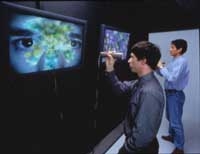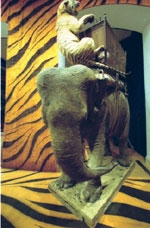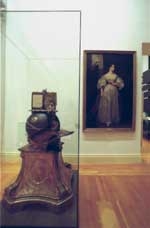Feature: Reviews
Expense Accounts of the Apocalypse
Seven Hills Spends Until the Crowds Go Home
Seven Hills
Martin-Gropius-Bau Berlin, Germany
May 14 - October 29, 2000
Stillegung Johannes Oberthür and Martin Supper
singuhr-hörgalerie Berlin, Germany
August 3 - September 3, 2000
At the entrance to the main atrium of the Martin-Gropius-Bau the first item in the sprawling “Seven Hills” exhibit is a small arena in which four Sony robot dogs play with one another (or do a reasonable facsimile thereof) as they tussle over an orange ball. Though they are cute, engaging, and undeniably entertaining at first sight, by the time you pass them again leaving the show some three hours later they serve as an apt summation of everything that is wrong with this art, science, technology, and culture megashow. Subtitled “Images and Signs of the 21st Century,” “Seven Hills” at Martin-Gropius-Bau in Berlin presents itself as nothing less than an extensive essay on the history of understanding.
The exhibition is divided into seven main sections- Nucleus, Jungle, Cosmos, Civilization, Faith, Knowledge, and Dream - each with itsown curator, exhibition designer, and catalog. Given its proud top-heaviness, you can sense trouble brewing even before finding out that the show carries the millennial price tag of 28 million DM. Located in the same room with the dogs as part of the Nucleus section are a robot that builds objects out of Legos, particle accelerators of various sizes, drawings of an 18th century earthquake in Lisbon, two robots used in the German branch of the Human Genome Project, a display on trepanation (skull surgery) complete with tools and skulls with extra holes, a Honda promotional demo about the development of their P3 walking robot, a 17th century image of cork cells, an interactive display where you can touch a virtual electrode to a virtual brain, Chris Burden’s “Atomic Alphabet,” and Rene Descartes skull (I’m displayed therefore I am?). This is far less than one tenth of the items on view in this one room alone and there are only 39 more to go.
While an argument for the inclusion of all these things side by side is plausibly made in the explanatory text (well, so long as you don’t think about it too much), a somewhat limited (and suspiciously enthusiastic) vision of the mind and its relation to intelligent machines is immediately apparent. Even the sharp placement of the Burden piece next to a tapestry that commemorates the 1666 opening of the Academy des Sciences in Paris doesn’t do much to dispel the notion that the exhibit is a modern wunderkammer whose high-tech baubles scarcely conceal the cabinet-of-curiosities logic lurking just below the surface.
By itself that conceptual deception is problematic, but more troubling is the frequent use of high-tech devices in an attempt to entertain away any deeper questions the exhibit might raise. In the Civilization Section, an unconvincing room shows images of water usage and containment includes the caution that “water will be the cause of future wars”.
This section is immediately followed by a large VR display that allows you to fly through various cleanly rendered cities that are, naturally, free of any human conflict whatsoever. Jungle, a section covering the construction of nature, includes a segment about the decimation of the tiger population complete with modern medical tools to aid in their reproduction and then a concentration-type game that allows you to match the genetic material via a bar-code scanner (if the tigers disappear, no worries! Anyone can cook up more in the lab).
Not that the exhibit is without its high points. Georg Ferdinand Otto Müller’s microscopic arrangements of tiny life forms, Anton Räderscheit’s post-stroke self-portraits, and the breathtaking design for the “Oceanic Feeling” section of Faith are proof that somewhere in this morass someone had a bit of vision that survived the design-by-committee protocol. It’s a losing battle, however, when stacked up against “Interactive Kali” (yup, the Hindu Goddess—don’t ask), “Hotel Digital” (where the extreme experience channel is all that’s on the tube), and “Thundering Emptiness” (which includes a badly-rendered boulder-sized egg, plenty of intrusive sound from adjacent rooms, and prominent track lighting). Those perky silver puppies at the entrance make apparent that, when a great deal of money and a good number of reputations are at stake, everyone is best off teaching a new dog old tricks.
Across town in the modest singuhr-hörgalerie, a spare collaborative exhibit by Johannes Oberthür and Martin Supper provides a refreshing antidote to all the bombast mentioned above. In "Stillegung" ("Stillness"), the exhibition space at the top of a church tower is divided into three parts using a set of horizontally-stacked windows on one side and vertically-stacked ones on the other. The horizontal stack blocks both access and vision to the space behind it but does allow occasional speech-like sounds to emerge. The vertical stack allows you to see into the space behind while denying entry.
This space emits several quiet sine tones that shift slightly depending on where you stand in the area between the two sets of windows. The windows themselves have been salvaged from the remodeling or demolition of local buildings, and the frames bear many marks of age and distress. Containing references to an ambiguous history of seeing in places that are now not what they once were, these unmoored windows are at once an artifact of change and a site where a shifting narrative can be inscribed and read with each new configuration of them. Combined with the sounds that accent the physical space of the viewer and listener, the piece illustrates the notion that knowledge is never fixed; it is something that changes both with the location of the viewer and with the tools for viewing.
The plain deployment of this concept here stands in stark contrast to the overblown presentation of the same idea buried somewhere underneath the Seven Hills. Simple, meditative and elegant, “Stillegung” leaves room for all the things that “Seven Hills” tries to explain away: wonder, mystery and the possibility to locate yourself physically and cognitively in the environment around you. The lesson here, that less can often be enough, is so clear that you wonder how the organizers for “Seven Hills” could have missed it entirely. As long as exhibits as understated and confident as “Stillegung” are around they will serve as a reminder that flashy interactivity and pseudo-educational entertainment are no substitutes for illumination and engagement.



